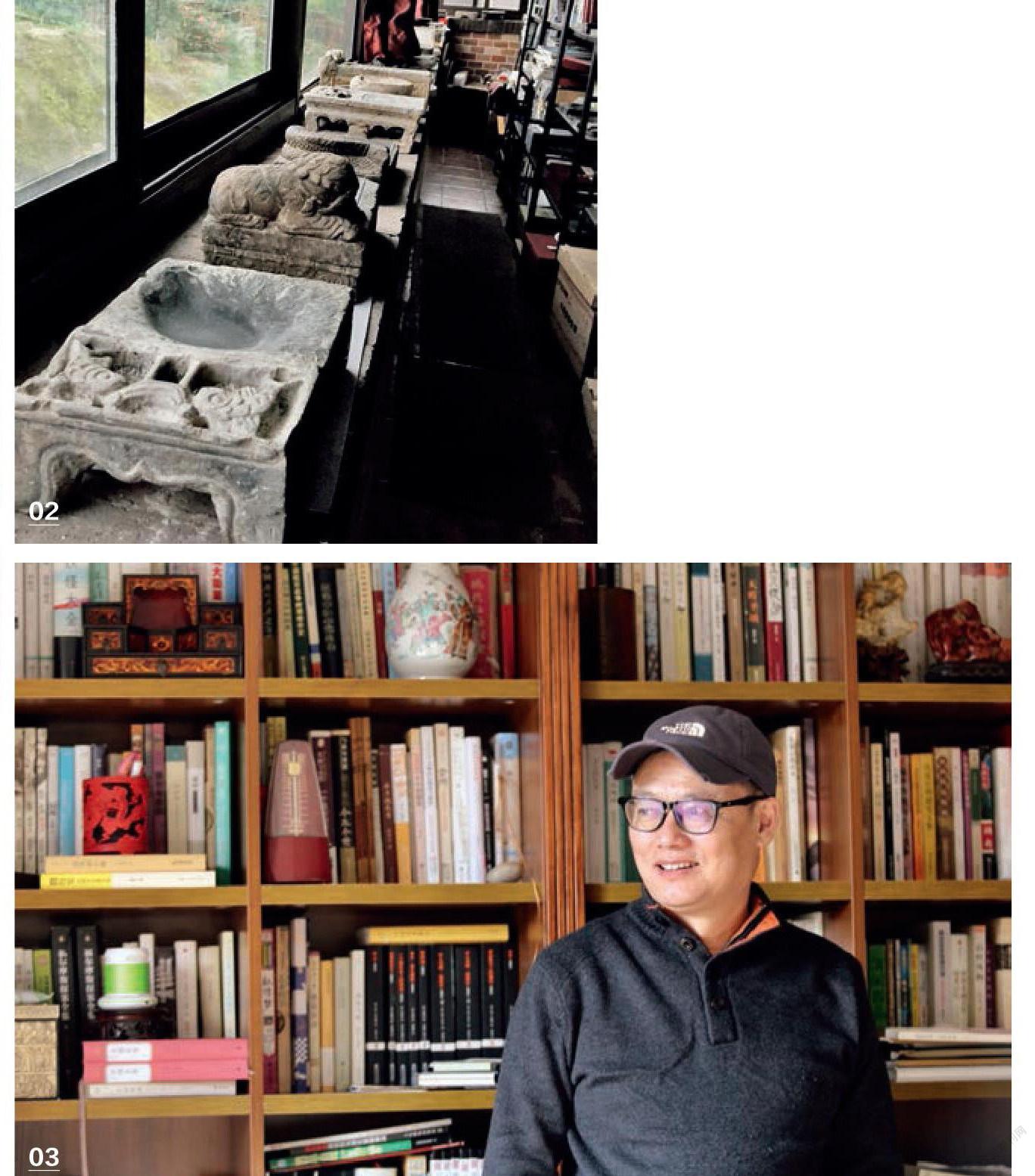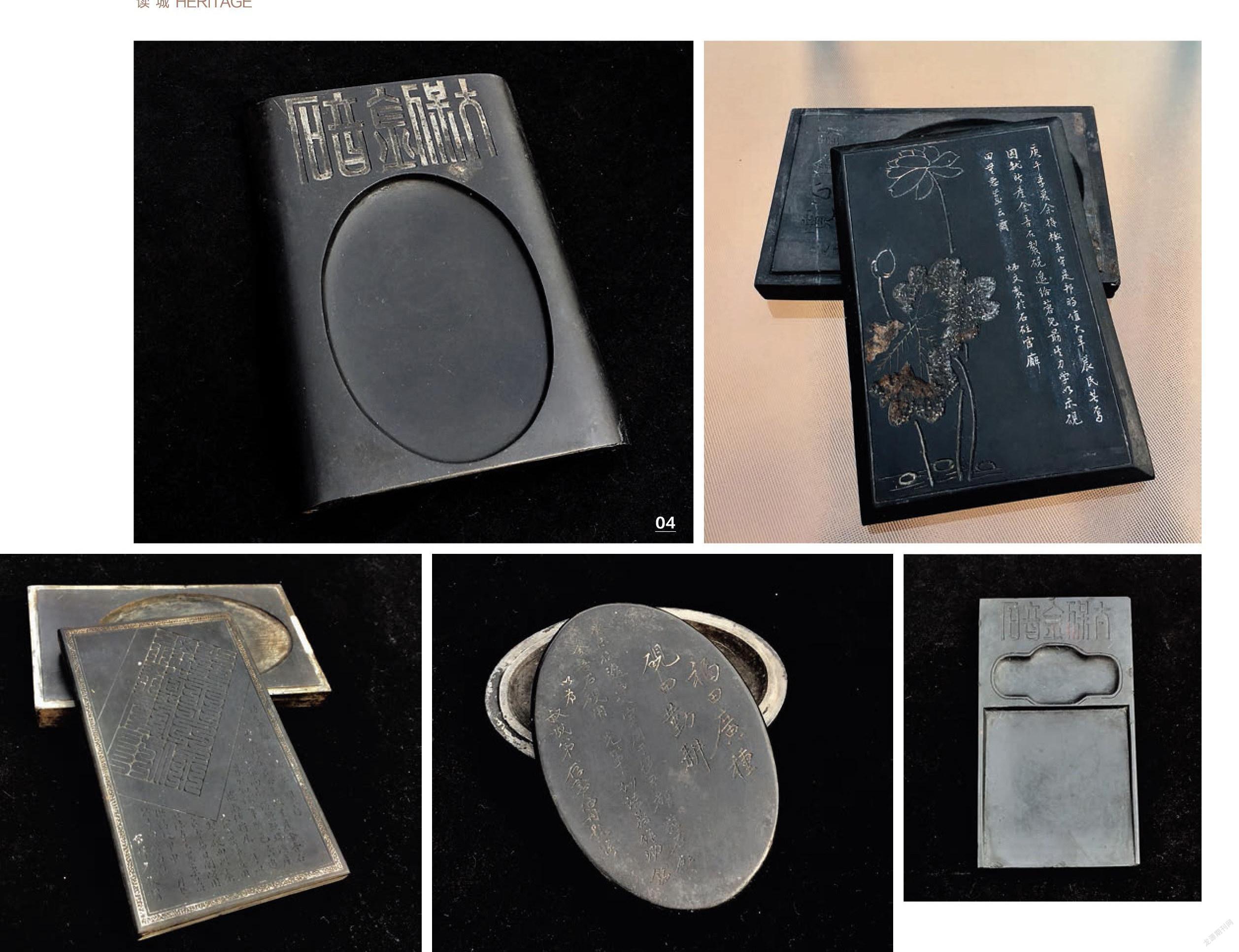金音石砚有传奇
2020-09-10胡婷
胡婷





“兼長翰墨世俱钦,一袭征袍万里心,艳说胭脂鲜血代,谁知草檄有金音。”1944 年, 郭沫若在重庆参观明末女英雄秦良玉文物展时, 挥毫写下了《咏秦良玉诗四首》,这即是其中之一。
在这首诗中,郭沫若作了一个注释,“石柱有金音石,可作砚,传秦良玉草檄用之。”
意思是说石柱县有一种金音石,可以制作成砚台,传说秦良玉就曾经用金音石砚来草拟过檄文。
金音石砚的来头可不小,它与重庆的夔砚、峡石砚并称“巴渝三大名砚”。由于历史上金音石砚制作时断时续,流传于世的精品更是凤毛麟角,渐渐地不为人熟知。
不过,在古砚收藏家、鉴赏家汪海的家里,我们有幸一睹金音石砚的风采,了解到金音石砚背后的诸多故事。
"Admired by the public, she's so adept at fancy writing; Wearing a coat armor, her heart is concerted with the homeland far away; The welling blood is her makeup; Who ever knows that she once drafted official calls with the gold-tone inkstone." Guo Moruo wrote the "Four Odes to Qin Liangyu" in 1944 when visiting the exhibition of Qin Liangyu, a female general of the late Ming Dynasty, in Chongqing. This poems is one of the four odes.
Guo Moruo made a note for this poem: "There are gold-tone stones in Shizhu County which can be used as inkstones. Legend has it that Qin Liangyu, a well-renowed female general in the Ming dynasty, used
in Bayu". Due to the intermittent production of gold-tone inkstone in history, the fine works circulated in the world are exceptionally rare, so they gradually became unknown.
Fortunately, at the house of Wang Hai, an inkstone collector, we had the honor to see the elegant demeanour of gold-tone inkstone and learn the stories behind it.
砚 中 传 奇 Legendary Inkstone
汪海家里,各种砚台琳琅满目,都是他收藏的川渝地方砚。
其中一方收藏桌上,几十余方墨黑色砚台在灯光照射下,散发出细腻的光泽。“这就是金音石砚,砚石产于重庆石柱凤凰乡砚台湾。”汪海拿起一方砚台,示意我们用手轻轻敲
打,果然有铿锵之声,如金石入耳。“这种石头声音清脆,所以被叫做金音石,也有叫金云音石的。”
汪海是安徽人,十几年前,因工作调动来到重庆。在川渝古玩市场发现金音石砚后,他爱不释手,开始了对金音石砚的收藏。他自豪地说,他收藏的金音石砚已有 30 余方,“金音石古砚典型形制、精品大多收藏在我手上。”
关于金音石砚,石柱至今还流传着一个传说。相传诗仙李白流放夜郎时,曾在石柱万安隐居。他在当地发现金音石砚后,十分喜爱, 吟诗作赋常伴左右,离开石柱时还不忘带上几方石砚作留念。
不过,传说终归是传说,明代以前金音石砚并没见于典籍文献,直到明末才因秦良玉而名扬天下。
汪海指着一块砚台上“太保金音石”字样的题刻说,“金音石砚因此又叫‘太保金音砚’。”汪海说,相传石柱女将军秦良玉有随身二宝: 武有白杆枪,文有金音砚。她两次率家乡子弟兵“白杆兵”进京勤王,后来被南明隆武帝封为“太子太保”“忠贞候”,并赐有“太子太保总镇关防”金印。石柱人引为自豪,故常在金音石砚上镌刻“太子太保总镇关防金印”或“太保金音石”字样。
Wang Hai's house is overwhelmed by a wide variety of inkstones, all of which were collected from Sichuan and Chongqing.
On one of the collection tables, dozens of black inkstones emitted delicate luster under the light. "This is gold-tone inkstone, which is produced in Yantaiwan, Fenghuang Township, Shizhu County, Chongqing."
Picking up one of the inkstones, Wang Hai asked us to tap it gently with our hands. As expected, there's a sonorous sound, just like that of the gold stone. "This kind of stone has a clear and crisp voice, so it is called gold-tone stone, or gold-cloud-tone stone." Wang Hai is from Anhui Province. He came to Chongqing more than ten years ago due to job transfer. Stumbling across the gold-tone inkstone in Sichuan and Chongqing's antique markets, he fell in love with it and began his career as a collector. He said proudly that he had collected over 30gold-tone inkstones, "Almost all the gold- tone inkstones in Chongqing are here with me."
There's a whole legend around the gold- tone inkstone in Shizhu County. It has that when the poetic genius Li Bai was exiled to Yelang, he lived in seclusion in Wanan, Shizhu. He couldn't be more in love with the gold-tone inkstone when first discovered it in the local area, and made the utmost of it when compiling poems. When he left Shizhu County, he also took several such inksotnes as souvenirs.
Yet legend is legend. No such inkstone can be found in ancient books and records before the Ming Dynasty. It got the nation- wide fame until the end of the Ming Dynasty, thanks to Qin Liangyu.
"Gold-tone inkstone is also called by some as 'Taibao Gold-Tone Inkstone'" said Wang Hai, pointing at the inscription on an inkstone, which reads "Taibao Gold-tone Stone". He told me that Qin Liangyu, the female general of Shizhu, has two treasures with her: a white spear and a gold-tone inkstone. She led the "white spear army" from her hometown to the capital city twice to show loaylty to the throne and was later dubbed "Tutor to Prince" and "Duke of Loyalty" by Emperor Longwu of the Southern Ming Dynasty. She was also given the golden seal of "General Town Guard of the Tutor to Prince". The people in Shizhu were proud of her, so they often engraved the words "General Town Guard of the Tutor to Prince" or "Taibao Gold-Tone Stone" on the inkstone.
砚中故事
Story behind the Inkstone
金音石砚虽自明末开始盛名,但早期作品流传极少。汪海所藏,都为民国年间所制,他十几年前倒是曾在古玩市场见过许多大约晚清民国时期的金音石硯,以民国早年居多。
通过收藏,汪海也展开了对金音石砚的系统研究,铭文是研究的重要内容之一。“好的砚铭往往是文字、书法、刻工三者俱佳的结合, 会增添砚的艺术与审美价值。铭文题刻一般是诗文或赠语,有题刻的砚台多为定制,制作也相对精良。”
研究铭文还有一个乐趣,汪海称之为“为历史存档”。
“现代人基本上不写毛笔字,但我们仍能从砚台中挖掘古人的智慧。”汪海的书架上有很多涉及砚台及川渝地方志的书籍,“砚铭不仅可以了解不同时期、不同产地的风貌特点, 还可以鉴古知人,帮助我们考定砚的确切年代、产地和曾经的主人,探寻关系人的历史文化价值,其乐无穷。”
汪海拿出一块砚台,砚铭上有这样一段文字:“劲益县长法家雅存。明太保秦良玉之故里产金音石,质莹洁而声清越,类端溪产。苏公知沆宰斯邑,余追随蒞任将届三年,以久客思归,爰用制砚,面刋秦良玉旧日关防,用以志古,呈置案头以供清玩。甲申三月,书于古南宾石砫。雷祥光敬赠。”
汪海解释,砚铭记述了雷祥光献金音石砚的故事,也记录了金音石砚的产地和特征。为了这段砚铭,汪海专门翻阅了《石柱县志》, 县志上记载,苏知沆在 1941 年担任石柱县长。
砚铭里的“甲申年”也就是 1944 年,想来大概是雷祥光见苏知沆任期将满,在积极为自己找出路。
汪海又拿起另一块砚台,指着上面的铭文解释,“这段铭文记载的故事也很有趣,说的是一个叫炳文的军官驻守石柱,正值大旱,他看到农民生活很苦,于是就用当地金音石制了一方砚,送给远方的孩子,其中有‘砚田无恶岁’ 之语,意思说只要勤学苦读,就一定有收获。”
在父亲对孩子的关切之外,这段铭文也记载了一段历史。汪海为此查了《石柱县志》, 里面记载了这场发生于 1930 年的旱灾,“收获仅十分之一二”。
The gold-tone inkstone, though got a great reputation at the late Ming Dynasty, the early works were rarely known to thepublic. Wang Hai's collections were made during the Republic of China. He did see works of the Qing Dynasty in the antique market more than ten years ago.
Besides his collection, Wang Hai also launched a systematic study on the gold-tone inkstone. Inscriptions are one of the important resources of his study. "A good inscription on the inkstone is often acombination of great writing, calligraphy and engraving, which adds artistic and aesthetic value to the inkstone. Inscriptions are usually poems or parting words of advice or encouragement. Inkstones with inscriptions are mostly customized and relatively well-made." said Wang Hai.
There is also a pleasure in studying inscriptions, which Wang Hai calls "archiving history".
"Most of modern people seldom practice calligraphy, so we can dig out the wisdom of the ancients from inkstones." On Wang Hai's bookshelves, there are a great deal of books about inkstones and Sichuan and Chongqing local chronicles. "Inkstone inscriptions can not only help us understand the features of different periods and producing areas, but also enable us to confirm the exact age, producing area and former owner of inkstones, exploring the historical and cultural values of that owner. It's incredibly fun."
Wang Hai took out an inkstone which reads: "Collected by the magistrate of Jingyi County. The gold-tone stone produced in the hometown of Qin Liangyu, a Tutor to the Prince of the Ming Dynasty, is pure in quality and clear in sound, similar to that of Duanxi. Mr. Su Zhihang was the governor of the region. I have been assisting him on government affairs for three years. Suffering from homesickness, I hereby make this gold- tone inkstone once used by Qin Liangyu to pay tribute to the old times. Please put it
on your desk for enjoy. Written in March, the year of Jiashen in Shizhu. Respectfully presented by Lei Xiangguang."
Wang Hai explained that the inkstone inscription recorded the story of Lei Xiangguang offered the gift (gold-tone inkstone) to someone, and also the origin and characteristics of the gold-tone inkstone. To figure out what this inkstone inscription meant, Wang Hai read the Records of Shizhu County, which writes that Su Zhihang served as the Magistrate of Shizhu County in 1941. The "Year of Jiashen" refers to 1944. It was probably that Lei Xiangguang, seeing that Su Zhimian's term of office was about to expire, was looking for a way out for himself.
Wang Hai picked up another inkstone and explained the inscription on it: "The story recorded in this inscription is also very interesting. It is said that an officer named Bing Wen was stationed at Shizhu County during a severe drought. He saw that the farmers' life was very hard, so he made a inkstone out of the local gold-tone stone which reads 'As you sow, so shall you reap' and sent it to his children from afar, aiming to tell them that as long as you work hard, you will definitely get something."
In addition to a father's concern for his children, this inscription also records a history. For this reason, Wang Hai checked the Records of Shizhu County, and found that a drought occurred in 1930, leading to very poor harvest.
